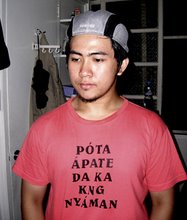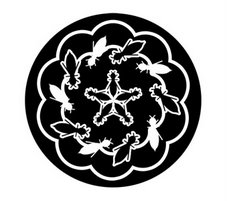
It's the macho men's ultimate test of manliness, probably the drag queens' ultimate Bayung Banua unreachable dream, and probably some feminists' nightmare.



This annual festival is locally known as Aguman Sanduk (Fellowship of the Ladle), which is celebrated in the afternoon of January 1, while the rest of the country takes a nap after the New Year's Eve revelry, and there's no one to catch the boys and men of this sleepy fishing town called Minalin wear their mother's lipstick and put on their wife's dress.




The tradition started in 1934 when a group of Minalin men, drinking beer in front of the old municipal hall, thought of a way to end the holiday season with a bang. They cooked lelut manuk, then dared each other to do the ultimate no-no among Kapampangan men: wear a dress and parade in the street. Someone put a pillow under his shirt and feigned pregnancy, another played a midwife and another an anxious husband; they mounted a gareta and the show was on!
When it was over in the evening, they did what Kapampangans of yore did best: perform crissotan (verbal jousts where poets composed witty verses on the spot). They also elected the first Aguman queen, Hilarion Serrano, who was described as the pekamatsura (ugliest), maragul atian (pot-bellied) and delanan ane lupa (literally, termite-ravaged face, or pock-marked).

Even mayors and parish priests are said to have also joined hundreds of men who parade annually the ugliest of the cross-dressers.




What's unique: it's part parody of Kapampangan machismo and Kapampangan pulchritude, two biases enshrined on the altar of Kapampangan values; it's part protest against, and liberation from, gender discrimination and repression.
It's part attempt to stage a version of the Gay Pride Parade except that its participants are straight (no homos allowed!) and it's their way of saying we can do it better and we can certainly look better and well, let's do something crazy for once!



An experience you won't forget: don't freak when you see ten-year-old boys wearing their sisters' dresses, and farmers and fishermen with sunburned skin and toothless grins wearing micro-minis over scarred legs and blonde wigs covering their bald heads.



The portrayal of the traditional woman may offend the radical feminists who would most likely raise concerns about the females being stuck in the underworld of unpaid, unregulated, and non-intellectual labor, which covers procreation, socialization of children, domestic work, preservation of the means of production, etc., in contrast with that of the so-called upper world of males (commerce, diplomacy, etc., in short, paid work).

The question is: does Aguman Sanduk show appreciation of the traditional roles of women in society? Or does it mock women?



 Text taken from Pampanga Online
Text taken from Pampanga OnlineFeminist notes and intro by this blogger
Festival's origin by Robby Tantingco







6 comments:
how could it claim to be a form of protest/liberation to/from gender discrimination when it predicated on exclusivity (i.e. no homos allowed)?
maybe it's just one of those silly antics of drunk men that snowballed into a festivity, with the government piggybacking for the sake of the tourists?
sorry for the typo... i meant "IT'S predicated..."
in analyzing psychographics, use points of view.
"form of protest/liberation to/from gender discrimination" could be on men's point of view.
of course, the spirit of the festival is shaky. the challenge for the townsfolk now is to give it meaning eventually. We suggest make it in appreciation of women's roles in traditional society.
Oh God! I cannot believe that there is such tradition in Minalin. You see, I'm from a neighboring city, San Fernando, and in my entire life, I haven't heard about that. I even have friends who live in Minalin but they haven't told me about that. This is very interesting. Lol lol lol!
you were there?! minta ku abak eh. ala pa. haha... mig-bike ku mu. i'm from sto. tomas.
as for the meaning, i think there hasn't been any deep explanation of this parade. it's more of a 'nakagawiang tradisyon' than a protest. but i'm not that well-informed either. maybe we can talk to those who are advocates of this tradition.
the writer of this article is obviously not from Minalin.. and doesn't even done his research about the real history of Aguman Sanduk.. it was never been started by drunk men.. lol
Post a Comment